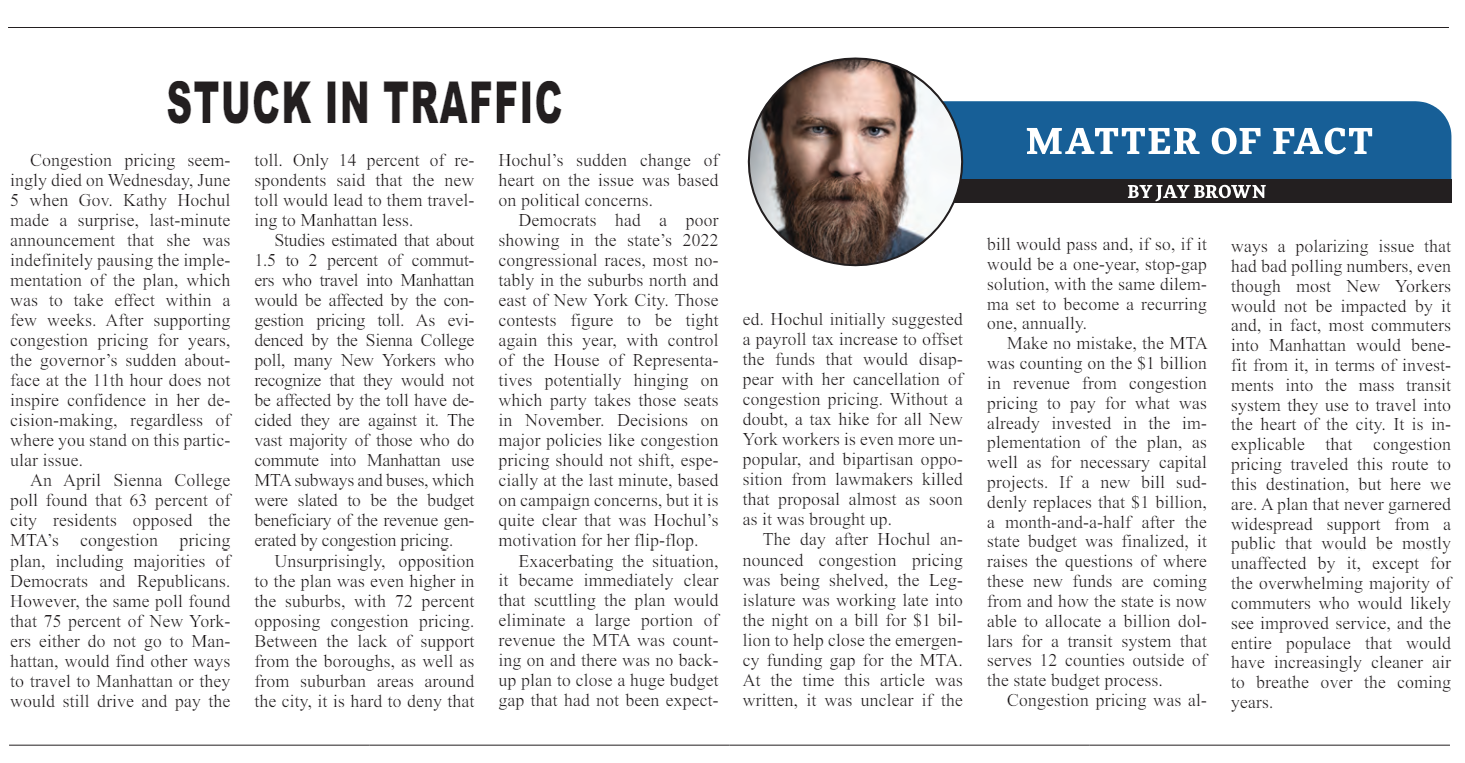This column, from the weekly opinion piece MATTER OF FACT, first appeared on BrooklynReporter.com, the Home Reporter and Spectator dated June 14, 2024
Congestion pricing seemingly died on Wednesday, June 5 when Governor Hochul made a surprise, last-minute announcement that she was indefinitely pausing the implementation of the plan, which was to take effect within a few weeks. After supporting congestion pricing for years, the governor’s sudden about-face at the eleventh hour does not inspire confidence in her decision-making, regardless of where you stand on this particular issue.
An April Sienna College poll found that 63 percent of city residents opposed the MTA’s congestion pricing plan, including majorities of Democrats and Republicans. However, the same poll found that 75 percent of New Yorkers either do not go to Manhattan, would find other ways to travel to Manhattan or they would still drive and pay the toll. Only 14 percent of respondents said that the new toll would lead to them traveling to Manhattan less.
Studies estimated that about 1.5 to 2 percent of commuters who travel into Manhattan would be affected by the congestion pricing toll. As evidenced by the Sienna College poll, many New Yorkers who recognize that they would not be affected by the toll have decided they are against it. The vast majority of those who do commute into Manhattan use MTA subways and buses, which were slated to be the budget beneficiary of the revenue generated by congestion pricing.
Unsurprisingly, opposition to the plan was even higher in the suburbs, with 72 percent opposing congestion pricing. Between the lack of support from the boroughs, as well as from suburban areas around the city, it is hard to deny that Hochul’s sudden change of heart on the issue was based on political concerns.
Democrats had a poor showing in the state’s 2022 congressional races, most notably in the suburbs north and east of New York City. Those contests figure to be tight again this year, with control of the House of Representatives potentially hinging on which party takes those seats in November. Decisions on major policies like congestion pricing should not shift, especially at the last minute, based on campaign concerns, but it is quite clear that was Hochul’s motivation for her flip-flop.
Exacerbating the situation, it became immediately clear that scuttling the plan would eliminate a large portion of revenue the MTA was counting on and there was no back-up plan to close a huge budget gap that had not been expected. Hochul initially suggested a payroll tax increase to offset the funds that would disappear with her cancellation of congestion pricing. Without a doubt, a tax hike for all New York workers is even more unpopular, and bipartisan opposition from lawmakers killed that proposal almost as soon as it was brought up.
The day after Hochul announced congestion pricing was being shelved, the legislature was working late into the night on a bill for $1 billion to help close the emergency funding gap for the MTA. At the time this article was written, it was unclear if the bill would pass and, if so, if it would be a one year, stop-gap solution, with the same dilemma set to become a recurring one, annually.
Make no mistake, the MTA was counting on the $1 billion in revenue from congestion pricing to pay for what was already invested in the implementation of the plan, as well as for necessary capital projects. If a new bill suddenly replaces that $1 billion, a month-and-a-half after the state budget was finalized, it raises the questions of where these new funds are coming from and how the state is now able to allocate a billion dollars for a transit system that serves 12 counties outside of the state budget process.
Congestion pricing was always a polarizing issue that had bad polling numbers, even though most New Yorkers would not be impacted by it and, in fact, most commuters into Manhattan would benefit from it, in terms of investments into the mass transit system they use to travel into the heart of the city. It is inexplicable that congestion pricing traveled this route to this destination, but here we are. A plan that never garnered widespread support from a public that would be mostly unaffected by it, except for the overwhelming majority of commuters who would likely see improved service, and the entire populace that would have increasingly cleaner air to breathe over the coming years.
